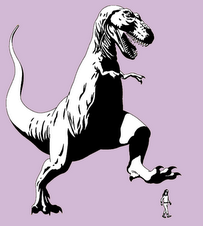"Hunting the Smiley-Face" by Anthony Setari
First of all, love the title! It reflects throughout the piece, in the way that none of the customers are happy and the way that Wal-Mart doesn't live up to its claims in your minds. I think you have a strong opening to this piece, especially the second paragraph. You show us the customers, and don't tell us too much about them. I love the sentence: "Two of her young sons trailed behind her and another son, a little past infancy, sat in the cart playing with a box of cookies, shaking it up and down to hear the crumbs mash and break against each other." It's such a clear, vivid image! Another great description comes on page 4: "The rotisserie chicken she had in her hand slipped and flung across the floor, leaving a squeaky trail as it soared ahead of her." I would like more description of the actual store itself; sure, we've all been to Wal-Mart, but what about someone who has never been there? How would you describe it? Are the floors clean and shiny, etc. You could also describe the grits aisle better (page 4-5). It took me a while to remember that grits are across from cereal, etc., so you may want to set up the space that this scene takes place in for the reader. Is there soda on that aisle? I thought your description of corn was really funny, but maybe a little long. Maybe you could format it differently, like in paragraph format? You could divide it up by types of corn, not brands, and put them into sentences that way. Just a thought. I like ending it with "That's a lot of fucking corn." It's a good way to present the issue of American consumerism, at least in my opinion. Do we need this many choices? Do we need prices this low? I like how you talk about the shoppers being in their own worlds (page 2-3 & 8), but how does someone look while their in this Wal-Mart trance? Also, funny reference to Stephen King Indian burial ground on page 2.
There's a lot of humor in this essay, but I think one issue you need to address is presenting people fairly. You let your biases with Wal-Mart and the small town culture that seems to thrive off of its presence influence your writing a lot. I think it's important for the reader to know how you view Wal-Mart, but I think it's also important for us to make our own conclusions about the people being observed. Like on page 3 when you write: "On the other hand though the store was also full of people 'getting ready to hunt some critter.' Interesting group, huh?" How did you know they were "getting ready to hunt some critter?" Were they looking at hunting equipment or wearing camouflage? Describe the people, don't make assumptions. I thought you did a good job on page 7 when you described the mother and her son looking at toys. You said that you "got the vibe she couldn't afford the ones he wanted" instead of saying directly, "They were poor." I think this kind of attention to detail makes a huge difference. If you are going to let your opinion seep in, make it clear that it is your opinion, maybe? I also don't necessarily like the sentence on page 7: "Okay, I vote Democrat so the thought of hunting for the most part to me is quite terrible but the notion that people hunt pigs is just...I can't even express it." Don't pigeonhole yourself as a narrator in that way. I like that you put thoughts like "I have never heard of anyone huntint pigs, where am I that there are people hunting pigs?!" That tells us enough about you without you having to say something about being a Democrat. You might want to think about putting your thoughts into italics, too, to separate them more from the concrete scenes that are going on. I liked the ending, it really tied it all together with the cashier smiling. I think you've got a great start here, Anthony. Maybe add more stuff in, more observations and detail, and maybe move some crots around. There are notes on the copy of the essay I have for you to look at, too. Good job!
Subscribe to:
Post Comments (Atom)


No comments:
Post a Comment